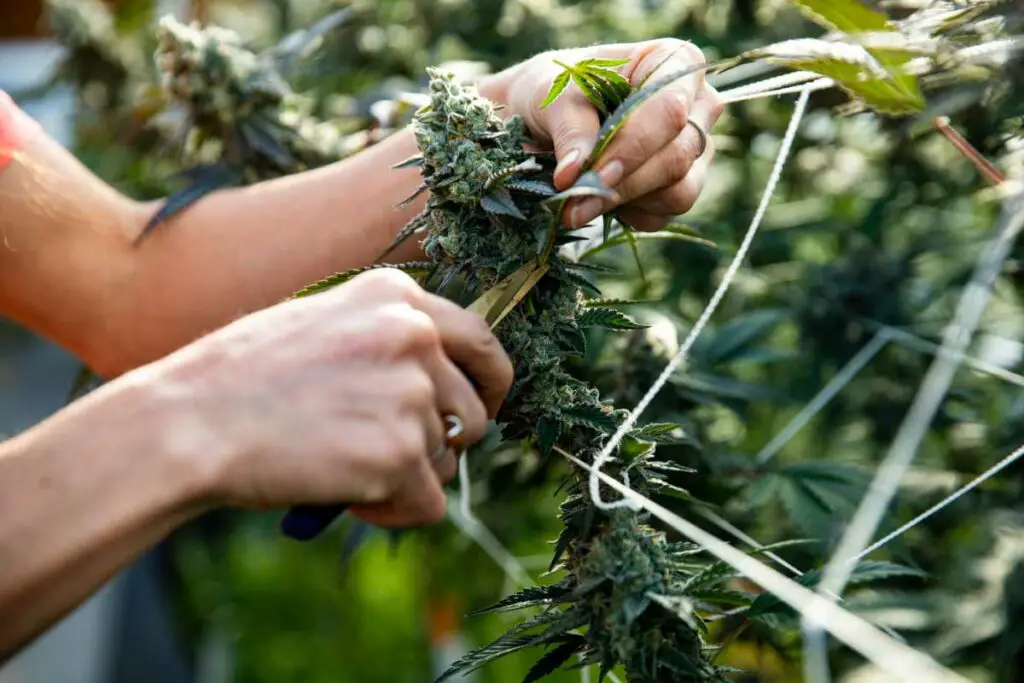Trimming cannabis is an essential process that nurtures the plant through its growth stages and helps it yield more.
Thus if you don’t trim cannabis, you undermine its yielding capacity— thwarting its production.
Trimming helps your plants in many ways.
First, the plant should have adequate light to hasten photosynthesis.
However, when the plant is bushy, even light of great intensity might not help much as the top leaves cast shadows on the lower bud sites.
Training your cannabis plant is a skill you must master if you have to gain the best out of every plant.
The plant also benefits greatly when air circulation is at its optimum.
Cannabis leaves twirl in happiness when the gentle breeze brushes through them. You can only guarantee excellent airflow when you trim the plant.
You mightn’t care much about the plant having fun and indulging in the gentle breeze, but you care about stale air in your grow room, and the danger of fungal infections, like mold or powdery mildew, destroying your crops.
By trimming your plant, you make them less susceptible to these fungal infections and bugs that love stale, stuffy environments.
Trimming saves you a great deal.

How Trimming Affects Cannabis Yield
Cannabis is a wild plant. The branches pick up new growth pretty quickly, and before you realize it, the top leaves are shadowing lower bud sites.
The lean plant can grow bushy in no time, and when that happens, the plant loses lots of nutrients sustaining excessive growth, and thus low yield.
On the other hand, when you trim the plant, you remove the excessive growth that steals from the plant’s nutrient reserve.
The plant gets enough resources to stretch its most robust branches creating more bud sites and a bigger yield.
It’s a known fact that bigger plants yield better when well exposed. Trimming enhances growth in the right places— equipping the plant with a robust structure to sustain the weight of burgeoning colas.
Perhaps we should clarify that trimming isn’t only limited to buds as most people assume.
Yes, you can trim the buds after harvest to aid the drying process, but in this article, we talk of trimming as the art of snipping out the parts of the plant that no longer serves it right.
Thus, we’ll use trimming and pruning interchangeably to mean a spirited effort to control the shape and size of the plant for maximum yield.
Trimming your plant to increase its lateral branching, promote light penetration, and enhance air circulation will improve your yield.
Here Are The Specific Ways Trimming/Pruning Helps Improve Yield
Nobody sticks to a practice that delivers no results.
Thus, when experienced growers narrate how good their hands have become at pruning their plants, listen and believe that trimming will improve your yield considerably. Here’s how;
Trimming Improves Light Exposure
Trimming the plant opens it up for light exposure. All the bud sites experience the light at its optimum intensity, thus, better yield.
When untrimmed, the plant’s canopy eclipses the bud sites on the other half of the plant.
Some lights are too weak to pierce through a bushy canopy to reach the bud sites below.
For instance, when using 400W fluorescents in your experimental garden, the flower bud sites are never ripe enough for harvesting.
High-quality LED lights with greater intensity will reach the bud sites below the canopy, but you still need to prune the plant for lower bud sites to get it in the right intensity.
When the other half of the plant doesn’t get enough light of the right intensity, it will slag in development and yield.
Trimming Improves Air Circulation
Your grow room needs to have quality airflow to nourish the plants and keep bugs and fungi at bay.
When the plant is thick with closely packed leaves at the canopy and along the lower branches, bugs find hidden spots where the air is stagnant and stale. Before you take notice, your grow room will be under attack. Hello, mold and bugs!
Trimming the plant opens it up for optimum air circulation. When the breeze hits the leaves, no crevice remains untouched where bugs can hide.
Pruning Gives Bigger Buds
Pruning involves removing the parts of the plant that the plant doesn’t need—leaving only branches that promise bigger buds.
The plant focuses its energy on the few buds, and when they’re well-nourished, the buds grow fat and juicy.
Also, pruning lengthens the lateral growth of the branches. Thus, more bud sites lead to more yield per plant.
So,If You Don’t Trim Your Cannabis, How Much Yield Do You Lose?
Well, it’s hard to put figures to this question because many factors determine how badly your plant is when it’s not trimmed.
Cannabis comes in many strains; some grow tall and less bushy while others are rotund and thick, with top leaves blocking everything below the canopy.
Thus, if your plant is less bushy, the light will still penetrate it easier than when the canopy is impenetrably thick.
Other factors that influence light penetration without trimming include; light intensity, the thickness of the leaves, and the spacing between the plants.
However, you shouldn’t think of trimming based on what you lose when you fail to do it, but rather on the much you can achieve when you do it correctly.
Trimming your plants and opening them up for light exposure and improved airflow can immensely improve your yields. Learn how to do it, and you’ll yield more than you ever would without trimming.
